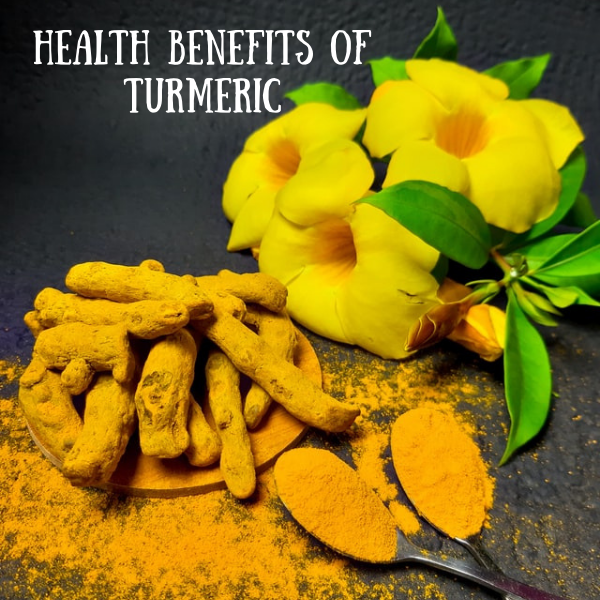Health Benefits of Turmeric

Get Healthy Fast with this Popular and Delicious Yellow Spice
Turmeric is a spice that originates from Asia. It has the longest list of health benefits of any popular culinary spice. Cooks use Turmeric for flavouring in curries, mustards, and a variety of dairy products. The spice is known for its bright yellow colour.
Now embraced by Western culture, Turmeric is known for various health benefits. They include protection against inflammation, immune system boosts and even anti-depressive qualities.
In this article, I look into the reported benefits one by one. While there are multiple scientific studies on Turmeric, this is not medical advice. The generational anecdotes combined with the studies show many positive signs. What they do not do is replace the advice / instructions given to you by a medical professional. This page ends with a look at the history of Turmeric and some of the foods that can benefit from the yellow spice.
Anti-Inflammatory Properties of Turmeric
Turmeric contains curcumin, which is a natural and strong anti-inflammatory. Long term inflammatory conditions can be a cause of heart disease. Regular intake of a natural anti-inflammatory can be an effective way to combat multiple conditions.
Studies comparing the anti-inflammatory properties of turmeric compared to those of anti-inflammatory drugs (non-Steroidal) have been promising. In the same vein, turmeric could have therapeutic properties for sufferers of arthritis, with similar encouraging results in tests.
This linked study shows promise – though with more work to be done!

Does Turmeric Have Anti-Cancer Effects?
There have been numerous studies surrounding the effects of turmeric on cancer. Many of the studies have shown that it can affect the formation and growth of cancer at a molecular level. It can also reduce the spread of cancer and can help contribute to the death of cancer cells.
This is such a complex area, with new scientific discoveries going on all the time. At this point, Turmeric / Curcumin has unveiled some molecular pathways worthy of further investigation. If you see this spice advertised as a cure, then make sure you speak to a specialist medical professional before you take it.
Turmeric Supports the Immune System
Studies have also shown that turmeric can have a positive effect on your immune system. Low doses of the spice can enhance antibody responses, which can help fight infection. In today’s world, fighting off infection has never been more important.
In animal studies, turmeric has also shown to be a good, natural way of fighting off allergies, including hay fever.
Curcumin (from Turmeric) Has Shown a Positive Effect on Alzheimer’s Disease
Curcumin plays a significant role in many of the health benefits associated with turmeric. As well as reducing inflammation it can also reduce the build-up of protein plaques in the brain. These plaques are a characteristic of Alzheimer’s disease.
Another ingredient of turmeric is turmerone, and studies have also shown that this can be beneficial in combatting the risk of both strokes and Alzheimer’s disease. It does this by helping trigger cell repair.
As with the other benefits, the ‘science’ is ongoing. Make sure you understand that the yellow spice should not replace the proper medication prescribed by specialist professionals.
Treats Depression and Anxiety
There have been a series of trials to see if turmeric can help with depression. It has been shown in several of those trials that the curcumin in the spice can lower depression scores and ease the anxiety levels.
Turmeric for Digestive Relief
In 2019, the European Medicines Agency reported that turmeric herbal teas could be used to relieve mild digestive problems. The feeling of fullness or flatulence can be alleviated by the intake of turmeric.
Of course, taking care of your overall diet and maintaining a healthy gut biome can avoid this issue altogether.

The Colourful History of Turmeric
The distinctive colouring of Turmeric mean that it was originally used as a dye rather than a foodstuff.
The colour was used to on the robes of priests and monks, as the spice spread across South East Asia on the back of the expansion of Hinduism and Buddhism. As well as being found in Asia, the spice has also been found in Tahiti, Hawaii, and the Easter Islands. There is also evidence that Turmeric was popular in Oceania and Madagascar.
Some of the earliest records of Turmeric was found in Farmana, India, dating to between 2,600 and 2,000 BCE. The spice was also found in a merchant’s tomb in Israel dating from the second millennium BCE. In medieval Europe turmeric was known as ‘Indian Saffron.’
In 1896, ‘The History of Mankind’ book, written by Friedrich Natzel, reported that turmeric powder was applied for embellishment of body, clothing, utensils, and ceremonial uses in Micronesia.
Culinary Uses of Turmeric
Turmeric is one of the key ingredients in a number of Asian dishes, mostly used in savoury foods. It’s most commonly used as one of the key ingredients in curry powder, but it is also used in many other foodstuffs, including:
- Canned drinks
- Dairy Products
- Ice Cream
- Yoghurt
- Orange Juice
- Biscuits
- Cereals
- Sauces
- Popcorn
The spice is usually used in its dried, powdered form, but it can also be used in its fresh form. Many Iranian dishes are cooked starting with a mix of caramelized onions in oil and turmeric. The Moroccan spice Ras el Hanout typically includes turmeric. In Thailand, fresh turmeric rhizomes are used widely in southern Thai cuisine, including dishes such as yellow curry and turmeric soup. In the Philippines, turmeric is used in the preparation of dishes such as Kuning and Satay.
The spice is also used for colouring of certain dishes (yellow rice is popular), including prepared mustards and chicken broths.
More Healthy Food and Fitness Pages: